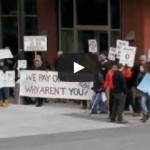Fuzzy Math Leads to Pension Hysteria
Ed. Note: This post comes from The Association of Deputy District Attorneys (ADDA), the collective bargaining agent representing nearly 1,000 Deputy District Attorneys who work for the County of Los Angeles.
Public employee pension systems are an integral part of recruiting and retaining high-performing public employees. They align the interests of the employer and the employee. A pension allows attorneys to work for the county District Attorney despite the prospect of a higher income in private practice. Once hired, DDAs have an incentive to stay during the most productive years of their career; and at the end of that career, DDAs can leave the office rather than cling to the job because it is their only source of income.
Pensions are particularly important in public agencies such as Los Angeles County, where employees are not enrolled in Social Security. Instead, a pension is the sole source of guaranteed income during retirement.
A District Attorney’s Office with a 401k plan in lieu of a pension will be an office with short-term and higher-cost employees. Future DDA’s, with neither Social Security nor a guaranteed pension will undoubtedly demand higher wages to pay bills and fund their retirement—or will leave for higher or equivalent-paying jobs in which Social Security becomes a backup income stream.
We know from recent media accounts that John Arnold is planning a national PR campaign against pensions. While we wait for Chuck Reed and Carl DeMaio to release the initiative details after they finish huddling with the out-of-state handlers who will be funding their pension rollback scheme, we will use this blog to address and debunk some of the dishonest arguments that have been employed against public pensions.
Overstating the costs of public pensions is a staple of pension opponents. It is sometimes done through outright lies, as seen by Chuck Reed who lied in the run-up to a 2012 pension initiative in San Jose. When he was mayor of San Jose, Reed repeatedly and falsely claimed the initiative was needed because 2015 pension costs would soar $650 million; a state audit revealed the 2015 projected costs to only be $320 million. (The actual 2015 costs ended up at $308 million.) Caught red-handed overstating the pension costs by 100 percent, Reed defended his false and misleading continual use of the $650 million figure by simply proclaiming, “The figure is not overstated, the figure is just a number.”
Another way to overstate costs is to inflate the cost of employer contributions. Pensions are funded by a combination of investment income and yearly mandatory contributions from employees and employers. Since annual investment returns cannot be known in advance, pension funds use “assumed rates of return” to estimate investment income for each year, with the balance needed each year coming from contributions. Pension opponents routinely generate headline-grabbing pension contribution costs by using assumed rates of return that are drastically lower than the pension systems’ assumptions because a lower assumed rate dramatically increases the employer contribution.
Yet another misleading tactic is to compare employer pension costs with prior years where the costs were unusually low. This is done by using as the comparison point a year in which the employer contribution was reduced or eliminated due to a “pension contribution holiday.” Employers often reduce their contribution in years where higher assets are generated by stock market gains. As outlined in a 2011 Paul Weber op-ed , using these artificially low contribution rates was a particular favorite of former Governor Schwarzenegger and his “special advisor,” David Crane. They often cited rates from the early 2000’s – which were lowered because of “pension holidays” funded by market gains in the late 1990’s as the comparison for then-current contribution rates.
The current controversy over the University of California system and the increase in tuition and costs, partly to fund employee pensions, is a notable example of how pension holidays end up affecting current operating budgets. In 1990, the UC system began a 20-year contribution holiday and used money that should have been paid into the pension system to fund ongoing operating costs. The result: funded status plunged from 156 percent in 1990 to 75 percent in 2010, when contributions resumed. The funded status would have been 120 percent in 2010 had contributions been made, and today’s larger payments would have been unnecessary.
Most recently, pension opponents have invented an argument that ongoing pension costs are “crowding out” other government services. In this narrative, every dollar spent to fund pensions is a dollar that could be used to hire more employees or provide more services. The “crowd out” argument, whether using actual or inflated pension costs, ignores several facts, such as: the municipal budgets are bouncing back from the lows of 2009; the CALPERS and CALSTRS studies have shown every $1 in pension payments generates $10.85 in economic activity; and that as a result of the Legislature’s 2012 pension reform, public employees are paying more for pensions, with new employees paying 50 percent of the costs.
When all else fails, opponents resort to the argument that public employees should not be exempt from the 401k scheme which, as we outlined in our last column, has failed in its goal to provide retirement income for Americans. This “race to the bottom” argument was the mainstay of a recent pension rollback initiative in Ventura County, where the slogan stated: “public employees should receive a retirement benefit that is no better than the citizens that pay for it.” Or, as an OC Register columnist recently stated, public employees are simply the lucky ones who get a secure retirement; “Folks watching their 401(k) accounts disappear can attest to that.”
We will continue to use this column to update you on the attempt to roll back your pensions, and provide factual information to combat the fallacious arguments that will be used to advance the initiative. Stay tuned.
Please read our previous blog titled “Your Pension is Under Attack” and if you want to learn more about pensions and get the facts, please visit a great website called Let’s Talk Pensions. It is run by Californians for Retirement Security, a coalition of more than 1.6 million Californians representing public employees and retirees.















